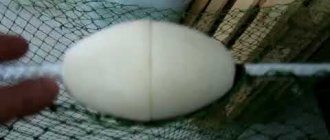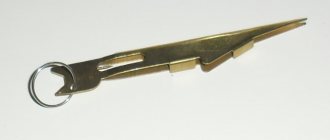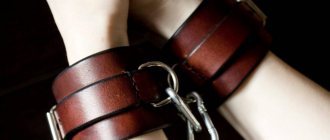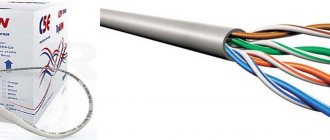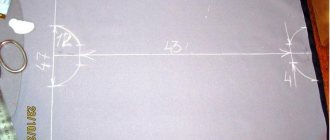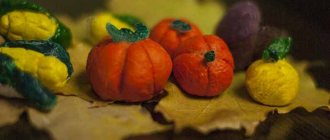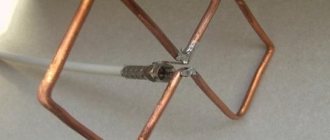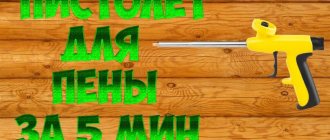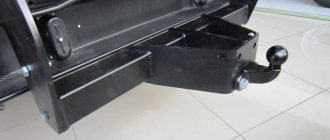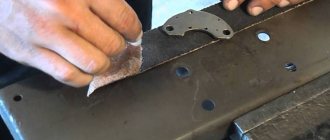You got acquainted with a brief technology for manufacturing the frame, the assembly procedure, and the dimensions of the beams of a homemade folding doll on the previous page of the topic.
It also covers issues related to the selection of fasteners.
Here, for novice fishermen, I will add some explanations related to the choice of frame sizes for a folding dab.
The dimensions of my homemade little fish are tied to the dimensions of the plane of a fine mesh with cell dimensions of 6x6 mm and side dimensions of 1x1 meter, which covers the frame when assembled for fishing.
With such a considerable size, you can quickly catch not only fry, but also live bait during summer fishing from the shore.
But you can make and assemble your own fry catcher with a much smaller mesh size, which is more convenient for catching fry from a boat.
In this case, there is no point in constantly grazing near a fishing device lowered into the water; it is enough to occasionally visit the fry on a floating device to replenish eland fry.
Sometimes the distances from the place of perch fishing to the relatively small-sized small fish, which are not always given the opportunity to be lowered into the water at the bottom of the reservoir, can reach two to three hundred meters.
In this way, we catch perch from rubber boats during their pre-winter feeding in late autumn in lakes. Then the cord coming from the fry is tied to a float, indicating the location of the installation of the device for catching fry.
How to make a baby doll from an umbrella
On the third page of the topic there are tips, using which interested fishermen can make a hatchling from an umbrella.
A homemade folding doll of a round shape has a relatively small size and a low rise when unfolded. This means that live bait can enter it from the very bottom. True, for the manufacture of fishing gear, an umbrella is suitable only with working knitting needles.
In addition, in order for the umbrella baby to properly perform its functions, you will need to make stretchers for it.
Then our fishing device with the fry can be lifted quickly without the threat of turning the fry net inside out.
If you are reading this text in the winter season, then perhaps you will be interested in the contents of the last page of this topic. It talks about how you can make a small fish from a bottle to catch small fish from the ice.
And for stationary fishing for fry from the shore, a more durable, also home-made folding fry with a frame covered with mesh is more suitable.
Homemade baby doll from an umbrella
Homemade dwarfs made from folding umbrellas are used for periodically replenishing eland fry when catching perch or pike with live bait rods or mugs on ponds and lakes from a boat.
They are no less successful in catching small fish from the shore with a small fish from a folding umbrella.
I have had the opportunity to make little umbrellas for myself and friends from folding umbrellas of various designs, with the obligatory subsequent washing of them at a richly laid table. Otherwise, the delicate workmanship of the homemade fragile tackle would very quickly fail.
The fewer articulated joints there are in the design of a folding doll, the more reliable it will be in operation. Less capricious are homemade devices made from non-folding cane-shaped umbrellas. True, when unfolded in a boat, the wrens take up a lot of space. Although for such fishing gear all the spokes can be shortened equally.
Warning! If the folding dabby is not properly equipped with a net, we may have one problem. In this regard, in the process of making this fishing device for catching fry from an umbrella, I will give some tips.
What kind of fish do you use to make live bait?
Not all underwater fauna is suitable for creating live bait, even if we are talking about suitable sizes. Of course, every small fish and fry has its own predator, but the requirements include not only the taste preferences of the caught pike or perch
It is important to consider qualities such as survival and transportability of live bait. In the summer we catch fish that are also able to remain attractive to predators with their behavior, and this is also a question of the survivability of the bait
As practice shows, the most valuable live bait is obtained from the following fish:
Crucian carp. It is distinguished by its vitality and universal taste properties, which attract a wide variety of predators. A simple, universal and common bait in Russian conditions. Loach. A very rare type of live bait that not only retains the appearance of a living prey, but also shows an interesting trolling game. During the fishing process, you can use both standard gear and a donkey with wiring. As for the target fish, the loach is also universal, but it is more often used for pike. Rotan. Also an attractive prey for pike, as well as perch. However, it is summer time that is not the most favorable for rotan. Gudgeon. It appeals to a variety of predators, but its vitality is low. Perch. And this fish is not famous for its long survival time, but in favorable conditions it can be used to catch very large specimens of pike and pike perch. Top melter. Like crucian carp, it can withstand the harshest conditions, being an attractive prey for rotan, perch and pike
But it is very important to choose the right moment when the predator itself moves closer to the upper warm layers of reservoirs and lakes, where the apex swimmer lives. Rudd
It is a rare case when a fish not only lives in a river, but also performs well as bait in the same conditions. Another question: how to catch live bait from rudd in the summer so that it retains the desired characteristics even outside the water? And for this, at a minimum, you will need special compressors with autonomous power supply. There is no point in saving on such equipment, since together with roach, this fish can provide a good catch. Bleak. Both from a boat and from the shore, bleak can be caught at any time of the year using a regular fishing rod with wiring. Next, you can focus on perch and pike, which will willingly rise from the bottom to snack on pelagic fish. Ruff. If you have a clear goal of catching burbot, then you can safely cook ruff. But it should be applied as quickly as possible, since it does not last long in warm conditions.
How does an umbrella bastard work?
For the folding parasol maker to work correctly, we will need to remove all the excess inside the cavity of the tube, which is better to replace with another solid one. Then the strength of the homemade dwarf will increase significantly.
As a result, all that should remain from the umbrella on the baby doll is a sleeve sliding along the tube with knitting needles hinged to it by a wire ring and a handle.
When the little fish is lowered into the water, the bushing should slide down freely under the weight of the wet mesh sewn to the ends of the spokes. If this does not happen, then the little bugger is not working.
In this case, we increase the weight of the bushing in any way. You can glue a thick-walled heavy metal tube onto the sleeve on top. To do this, we will have to find a tube with the appropriate internal diameter.
After such a simple modification, a homemade little bugger made from an old umbrella will begin to work according to our rules.
Umbrella for folding toy
Let's first look at the designs of folding umbrellas that are most suitable for making a do-it-yourself baby doll.
Firstly: if you try, you can find a folding umbrella with damaged covering material at home or at your neighbors’ without much difficulty.
Naturally, the spokes of the umbrella should also be foldable and it would be better if they are made of stainless steel with chrome-plated bronze.
It is also desirable that the awning of a folding umbrella rest on a base made of a fan of numerous spokes. Then the perimeter of the mesh between the spokes will not sag when the wren is lifted from the bottom (photo 1). And there will be less load on each knitting needle when the fish catcher quickly lifts the fish from the bottom of the reservoir.
Here I deliberately introduced strict requirements for the umbrella, converting which into a folding little one will not require much time. In fact, the umbrella can be anything; its end handle can also be remade.
Various do-it-yourself fishing crafts
A real fisherman does not limit himself to buying a ready-made fishing rod.
Even many professionals make some elements of gear with their own hands.
It is sometimes difficult for a novice angler to understand why his fish refuses to bite, while his neighbor pulls one trophy after another out of the water. And even when a fellow hobbyist generously shares his catchy bait, the situation does not improve.
Often the reason for a lack of bite lies in incorrect settings of the tackle or in the use of floats that are too large.
Let's look at a few homemade products that are so simple that they can be easily made by any novice angler.
Choosing a net for a dwarf from an umbrella
If we have found an umbrella that is suitable for its design, then let’s choose a mesh for making a do-it-yourself umbrella. Here we may encounter such a problem.
If you choose a net with a small mesh, say 6x6 mm, for the hatchling, and knitted from relatively thick threads, then when the umbrella is quickly lifted, the knitting needles will bend in the opposite direction and all the fry from the hatchling will break free.
The high density of water for a homemade dabble with a fine mesh knitted from thick nylon or nylon threads has a very high windage.
Remember how the spokes of an umbrella fold in the opposite direction in a strong wind, when its gust hits the inside of the awning stretched on the spokes.
Therefore, the choice of the size of the cell and the fishing line or thread from which the mesh is knitted on our homemade fry will largely depend on the speed of the fry’s rise to the surface of the water.
Types of live bait used
Live bait can be divided into several types:
- The best live baits are those that remain mobile for a long time, while attracting fish. Such live baits include crucian carp and gudgeon.
- Live bait of the next type does not move so actively and falls asleep relatively quickly. They need to be shaken periodically, moving the tackle a little. Most fish belong to these live baits. Among them are roach, ruffe, and perch.
- The most unsuitable live bait will be fish that live near the surface of the water. They quickly fall asleep and stop attracting predators. These fish include bleak.
Homemade nets for fowl
Once upon a time, nets made of fishing line about 0.2 mm thick were knitted to their homemade parasols. The choice of cell size is determined by the size of the fry we need.
Therefore, when lifting a small fish with a thin net, the water did not provide such significant resistance to the cells of the fishing line passing through its horizons.
For those who don’t have such a fishing line mesh, choose an industrially made mesh for the dwarf. In the process of manufacturing the fishing device, we will strengthen the structure of the homemade little fish with additional braces.
The photo under the title of the article shows one of my most popular shuttles. It is made with your own hands from hardened duralumin 1.5 mm thick. Under the shuttle there are three templates that allow you to knit meshes for screens, landing nets or hatchling nets with cell widths of 15x15, 20x20 and 25x25 mm.
Although, using the same shuttle, provided that it is not filled too much with thread or fishing line, it is quite possible to knit a net for a fowl from an umbrella with a mesh side size of 8-10 mm. Although, if you look, somewhere in the trash you will find shuttles both narrower and wider.
Do-it-yourself self-catcher (supply or girder) for pike from a plastic pipe
He himself, like his father, call such homemade gear “self-traps.” For them, the zherlitsa is a circle with a bright flag.
Well, the principle of all these rigs is the same - when a predator, for example a pike, attacks, the elastic band is triggered. And the pike begins to reel in the cord or fishing line.
When self-trapping, the cord is released and reveals a bright “device” to the fisherman’s gaze. And in the case of a regular girder, a flag “shoots”, which is also visible from afar.
Making a self-catcher is simple, and if you have free time in the evening, you can make a dozen of them.
To do this you will need: a piece of plastic pipe 10-11 cm long (such a pipe is used in plumbing), a self-adhesive red film, a leash, a sinker, a winding ring, a swivel and a hook (either a double or a tee - whoever catches with what).
First, let's take care of the tube - make several cuts for the fixing elastic band and leash and a hole for the cord.
Next, carefully stick a self-adhesive film onto the middle of the pipe. We will stretch the end of the cord into a special hole, make a loop and secure it with knots on both sides of the pipe. We wind the cord (5-10 meters long) to the place where the film is installed.
At the other end, we first mount a sinker, then a swivel, a winding ring and a leash with a hook. We can say that the homemade self-trap supply (zherlitsa) is already ready!
Crucian carp is often used as live bait in summer, and roach or perch in winter.
Watch the video to see how this cunning fishing tackle is made and how it works:
Do not judge the author strictly - there are other options and they are called differently. The main thing is to do it yourself and the main thing is that they perform their function. And they do it perfectly - they work with a bang!
NHNCH (No tail, no scales) to everyone! Follow my new publications - it will be even more interesting!
Making a dwarf from an umbrella
Next, we proceed directly to making a folding baby doll from an umbrella.
To do this, take an umbrella with a frayed old awning, open it and use a blade to cut off all the fastening nodes from the threads that attach the silk to the knitting needles.
We unscrew the screw from the tube in the middle of the awning. They are usually made of plastic in the shape of cones with a truncated top.
By now, many designs of folding umbrellas have been invented and manufactured, but if you are not going to knit a net for the baby bird yourself, then it is better to find an umbrella with a handle that has a straight end plane.
Next, we lay out the mesh of a homemade folding doll on the table and press it along the perimeter with suitable heavy objects.
Then unfold the umbrella, place it vertically with the handle up and sew the mesh along the outer perimeter with thin nylon threads to all the spokes of the umbrella. Each spoke has a hole for this purpose. At this point, we will assume that the working base of our folding doll has been manufactured.
But before sewing on the mesh, I always lower the sides of the future hatchling. To do this, I align the knitting needles along almost the entire length, leaving their bend along the edge 5-6 centimeters long intact.
I also recommend sewing the fowl mesh to the spokes of the umbrella, not in a row in a circle, but with a slight tension on opposite sides. This way the mesh will lie more evenly on the knitting needles.
The result: we got a homemade umbrella with a holey awning. To complete the production of the doll, all that remains is to sew the mesh in the places where the knitting needles fold together. That is, where the seams of the silk tent were previously sewn.
In the last operation of making the umbrella, we screw the original or third-party screw into the tube (where the top of the umbrella awning was attached). If it falls through the cell of the hatchling, then place a washer under the screw. And, of course, the height of the head of the central screw y should not be as huge as shown in photo 1 at the beginning of the page.
After that, the manufactured umbrella with the fowl net stretched over the knitting needles should be folded. Of course, the grid will not be formed in such a small volume as we would like. But the main thing is that the umbrella folds.
After this, a rope made of cord or twine is tied under the handle of the umbrella and our folding hatchery is ready for work, but with a SLOW RISE in the water column. This could result in some of the fry leaving the surface of the hatchling net.
Therefore, let's significantly strengthen its design.
Whitebait and small fish - bait for predatory fish
Many fishermen in the spring and during the autumn feeding period of perch, pike and pike perch, catch them with live bait - live small fish or juvenile fish, which live in large quantities in the coastal zone, rich in vegetation.
Of the large variety of existing natural baits for predatory fish, live bait is the most popular of them and an effective, undisputed alternative to artificial baits, which is in great demand not only among avid fishermen, but also among novice fishing enthusiasts.
As live bait, they use tenacious species of small fish that do not “fall asleep” on the hook for a long time. Well suited for these purposes; medium-sized perch, roach, ruffe, gudgeon, small crucian carp, worse - redfish and bleak, the goby does not fall asleep on the hook for a long time, but hides under the stones.
The e-book “Fishing for Beginners” will answer all your questions and will be the best assistant in mastering this activity. More details
Not only pike, perch and pike perch are caught very well with live bait, but also asp, trout and other predatory fish. Large specimens of peaceful ichthyofauna, such as carp, carp, and silver carp, also happily eat similar juvenile fish.
Cannibalism occurs in most species of freshwater fish, from which they do not particularly suffer, so using bait from live small fish you can catch any large fish living in a given body of water. Even such purely herbivorous fish species as White Amur and Silver Carp, during the autumn feeding season, show increased interest in the fry.
The size of the live bait used for bait is dictated by the size of the individual being caught. To catch small perch, they make do with small live bait (3-5cm), and for trophy specimens of pike, they often use small crucian carp or fish weighing 150 - 200g, which are quite suitable for fishing.
It is advisable to catch small fish in the same body of water in which you plan to fish for them. In this case, the caught live bait will be more likely to succeed, since it will be the daily food supply for predatory fish. In practice, it has been established that very often guests from another reservoir, serving as live bait, are not popular with local representatives of the predatory ichthyofauna, since they are not found in this reservoir and are not included in the food diet of those marked.
There are many methods and devices for catching live bait. The simplest of them, if you have an assistant, is catching small live bait - fish fry using a small piece of gauze (1.2 m x 0.7 m).
Gauze, previously rolled in silt and having lost its whiteness, sinks to the bottom in a shallow place, where a large accumulation of fry was noticed and is held in a tensioned position on both sides, so that it can be quickly lifted at the moment a small fish appears above it , without missing it. Frightened by your uninvited appearance, the fry will appear again after a while, after you set the trap, you just need to be quiet and wait a little. If you use pearl barley porridge or bread as complementary food, crumbling it over an improvised net, then the return of the live bait to the right place will happen much faster.
Also, to catch fry and small fish, they use homemade traps from plastic bottles and drinking water containers, which can be found in any body of water and can be made literally on your knees. To do this, you need to cut off the top of the container and place it with the neck inside the bottle, setting up a trap according to the “top” principle, in such a way that the victim could easily get into it, but would not be able to swim out.
Increasing the strength of a homemade dwarf
In order to reduce the likelihood of reverse bending of the umbrella spokes when the fry is quickly raised, we need to strengthen them with braces, giving the umbrella spokes additional rigidity.
The figure shows the following components of a homemade doll, which you need to select or make with your own hands.
If you do everything as shown in the drawing, you will significantly increase the rigidity of the do-it-yourself doll.
In order to increase the strength of a homemade folding umbrella, giving it sufficient rigidity, you can proceed as follows:
Select a pair of a nut and a short bolt (not a screw) with an M5-6 thread. Embed the nut (with a soldering iron or drill and file it) into the hole in the middle of the end plane of the plastic umbrella handle.
If the connection between the nut and the umbrella handle is unreliable or it protrudes too much above the plane, then glue a paper cup (formwork) along the outer perimeter of the handle and fill it flush with the surface of the nut with epoxy resin.
After the resin has set, clean and polish the handle of the folding umbrella, check the fit of the bolt into the nut.
Then, in the middle of the bolt head, use a hacksaw blade for metal, make a cut into which insert a coin ground off the edge, which is firmly soldered into the cut of the bolt, drill a hole in it for tying the lifting cord of the doll.
Thus, our homemade little bugger from a discarded umbrella has already begun to cost exactly more than a hundred rubles and, in addition, we will be able to tighten the bolt into the nut without resorting to a wrench or pliers.
Well, since a bolt and nut appeared in the design of the folding doll, then let's cut out or cut out a round washer from sheet metal 2.5-3 mm thick and drill a hole in the middle for the passage of the bolt.
Although you can cut the washer out of durable plastic. This device will serve as a support for the stretch marks tied to the spokes of the baby doll.
The diameter of the washer (“B”) should be such that it protrudes beyond the handle of the folding umbrella. In addition, we drill holes with a diameter of 2.5-3 mm in the rim of the washer protruding beyond the diameter of the handle.
Then we put the washer on the nut, tighten it with a wing screw, unfold the little umbrella from the umbrella into the working position and tie each knitting needle to the holes in the washer with a stretcher made of thick nylon threads. You can tie several guy wires in each hole of the washer.
The rigid structure of the folding umbrella can be lifted out of the water much faster.
READ MORE:
Similar summer fishing topics
Source
Dimensions of the folding baby doll
You got acquainted with a brief technology for manufacturing the frame, the assembly procedure, and the dimensions of the beams of a homemade folding doll on the previous page of the topic.
It also covers issues related to the selection of fasteners.
Here, for novice fishermen, I will add some explanations related to the choice of the size of the frame of the folding fisherman and the bait that does not fall through the mesh.
The dimensions of my homemade little fish are tied to the dimensions of the plane of a fine mesh with cell dimensions of 6x6 mm and side dimensions of 1x1 meter, which covers the frame when assembled for fishing.
With such a considerable size, you can quickly catch not only fry, but also live bait during summer fishing from the shore.
But you can make and assemble your own collapsible fry fishnet with a much smaller mesh size, which is more convenient for catching fry from a boat.
In this case, there is no point in constantly grazing near a fishing device lowered into the water; it is enough to occasionally visit the fry on a floating device to replenish eland fry.
Sometimes the distances from the place of perch fishing to the relatively small-sized small fish, which are not always given the opportunity to be lowered into the water at the bottom of the reservoir, can reach two to three hundred meters.
In this way we obtain fry for catching perch from rubber boats in late autumn on ponds and forest lakes. Then the cord coming from the fry is tied to a float, indicating the location of the installation of the device for catching fry.
Although for catching fry from a boat, as well as for fishing from ice in winter, it is much more convenient to use a homemade folding small fry, made on the basis of an old umbrella, which is covered with mesh at the bottom. And the bait is attached to the net.
Currently, I don’t have this fishing device for catching small fry, but I have made quite a few similar small fry in my life.
Therefore, on the next page of the topic I will place a drawing of another homemade folding baby doll with all the necessary drawings and the technology for making it yourself from an old umbrella.
Or you can make a much simpler fry from an empty foam container of any reasonable size for catching fry from a boat. True, the device is not foldable, but collapsible. And the container should be transparent with the bait visible inside.
But you will get rid of the work associated with the manufacture of a steel frame and the search for fine mesh.
Who is live bait and why is it caught?
Live bait is an integral part of fishing, and accordingly, every fisherman, both beginner and experienced, must be able to catch it. In our article today, we will consider this issue in detail and find out the main nuances that affect the productivity of this matter.
It is used as bait for catching larger and more predatory fish. Both juveniles and adults can be considered live bait. In our area, fishermen most often bait fish with fry, for example roach or crucian carp.
It is considered to be the best natural bait that fishermen are accustomed to. This method is most popular in autumn, winter and spring, at a time when there is less food in the water.
Where to look for fry and how to catch them
We will tell you some of the most basic methods; they can be used at any time of the year. The methods are very simple and do not require serious skills or a lot of gear. We should start with the fact that it is more convenient and easier to fish in shallow water. In this place, the water warms up stronger and faster, and small fish accumulate in large quantities.
If you sprinkle a little bran, the fishing efficiency will increase several times; the fact is that the bran will create a “dust cloud” that attracts schools and flocks. Collected fry in one area can be picked up using a landing net or spider.
A spider is not an insect, but a collapsible metal frame covered with a mesh with a fine mesh; the fry will not pass through it. Some manage to catch it with fishing rods. To do this, use small hooks; if you are catching small perches, if you need to catch small ruffs, use larger hooks. It is easy to catch a gudgeon close to the shore, making the water cloudy in advance.
What kind of fish can be used as bait?
- Crucian carp is an effective way to catch pike. The pike perch has a small mouth, which means it is not capable of swallowing every relative, preferring to choose the high water;
- Rudd is quite effective, since after baiting the hook it remains mobile for a very long time and attracts large individuals;
- Perch – both large perch and pike can be caught well with fry, as we have already discussed above. Some fishermen decide to plant the fry in parts;
- Ruff is the most favorite bait of fishermen who want to catch burbot;
- Gudgeon is also excellent for catching pike and has shown itself to be even more effective when catching pike perch. Unfortunately, the gudgeon cannot be active and mobile for a long time. This is its significant disadvantage. If you immerse it at a depth, where the water temperature is lower, it will be active for a longer time. Interestingly, pike bite well on it where gudgeon are not found at all. Most likely, this is explained by the similarity of the gudgeon with the squirrel. To catch such bait, you can take a simple bottle, gauze, which is used to tighten the neck and crust of bread. The bread is placed in a bottle, the neck is tightened with gauze, a hole is made in it and lowered to the bottom. Then, at regular intervals, the bottle is checked for the presence of live bait;
- Loach is perfect for pike perch, pike and many other bottom predators, notable among them being burbot and catfish. It is best to fish with loaches where this species is found. Look for him in the mud, where he hides. If bad weather is expected, the loach is the first to rise higher.
Wobblers that catch 100%:
Bottom line
Interestingly, in some countries of Western Europe, the use of live bait is prohibited. Edible rubber is most often used as bait. There are no such restrictions in our area yet. The main thing is to find a parking place for schooling fish, which is quite simple to do. Follow our advice and you will definitely succeed.
Making a folding doll
The manufacture of a folding doll begins with the selection of purchased threaded fasteners and bending of the frame beams, about which material is given on the previous page of the topic. Although the process of making a homemade folding device for catching whitebait in the summer can be simplified.
Why do we tie a small fish with a stretched net when fishing to twine using a soldered ring, and to a bolt, which is the axis for the rings of the sliding arms of the frame, the size of which you can also reduce if you wish. The absence of a ring will allow you to avoid soldering work when making a folding doll.
When assembling all the manufactured beams of the folding frame of the doll, we place thin washers between the rings. By tightening the wing nut, we adjust the tight movement of the crawler rays around the bolt.
We screw a regular nut onto the bolt, not a wing nut. To prevent it from unwinding, the threads should be set on paint or, at the final stage of manufacturing the malyavochnik, the threads protruding beyond the nut should be hammered in with a hammer.
True, then our homemade doll, made using simplified technology, will no longer be collapsible, but simply foldable. After complete disassembly of the device for catching whitebait, the bolt and nut will have to be replaced.
This is all I can tell you about making a copy of the frame of my little fish with my own hands, intended for catching fry and live bait during summer fishing, which can be used for catching pike in the summer.
If we have figured out the list of components and the sequence of manufacturing a folding fry, then let’s think about the size of the opening of the homemade frame, which you can change for the convenience of catching fry on your fishing trips.
Dimensions of the folding baby doll frame
It should be explained where I got such “strange” dimensions of the folding frame of the baby doll.
To do this, let’s pay attention to photo “2”, which shows the frame of my homemade fry fish in an expanded form for catching fry, but so far without a stretched net.
It turns out that the dimensions of the folding beams offered to you are adjusted to the dimensions of the grid with side dimensions of 1x1 meter.
The mesh itself is not stretched, but the outline of the mesh fabric is shown in the form of a stretched green cord.
If the size of any beam of a folding frame, equal to approximately 75 centimeters, is squared, then the result is multiplied by 2 and the square root is taken from the resulting product, then the quotient obtained by the Pythagorean theorem will be equal to approximately 1 meter. Check it out.
With such standard dimensions (1x1 meter), in the decaying Soviet Union, nets for fowl were produced.
As far as I remember, back then, to make a folding doll with your own hands, you could find meshes in the store with cell sizes of 5x5 mm, 6x6 mm and 10x10 mm with standard side dimensions of 1 meter.
The dimensions of my folding fishing device suit me quite well for catching fry and live bait from the shore.
In industrially manufactured nets, a nylon cord is stretched around the perimeter. I have 4 loops tied to this cord at the corners of the mesh, which just need to be thrown over the end brackets of the rods of the homemade doll.
After this, you get a completely rigid design of a folding device with the dimensions indicated above, which is used to catch fry during summer fishing.
In addition, the rigidity of the dwarf increases the small weight tied in the middle of the net. I usually attach a piece of stale bread to the load as bait.
As I already wrote above in the text, for catching fry in winter fishing from ice, fishermen on the following pages of the topic are offered two more designs of winter fry with much smaller sizes.
If desired, both fishing devices can be used for catching whitebait and during summer fishing.
And, if we are talking about summer fishing, then I made a folding landing net with my own hands from a rod of approximately the same diameter.
I only recommend stretching a triangular-shaped net over the opening of the landing net with a cell larger than that of a home-made dwarf.
Assembling a fishing rod
The entire assembly of a small fish for catching whitebait on summer fishing consists of four beams and their fastening articulation using an M5 bolt and a wing nut with the same thread.
The assembly sequence is as follows.
First, the rings of all four beams of the folding frame of the homemade dabble are put on the bolt. Then a simple and spring washer is thrown on. Then this economy is tightened with a wing nut.
In the center of the bolt on my little fish there is a ring soldered, which serves to tighten the frame assembly and to tie the device to some kind of cord or twine during summer fishing. As far as I remember, I sawed off the ring for this assembly of the malyavochnik from the “gander” of the water mixer.
All frame rods in the same place (near the curved rings in the assembly area) should be bent at the same small (5-7 degrees) angle.
Thanks to this simple operation, our homemade little fish will lift it 12-15 centimeters above the net in summer fishing conditions. Although you can bend the rods on the malyavochnik in a small arc along their entire length.
The assembly assembly of the frame of the folding dabble is shown in the photo, but for use in fishing conditions there is not enough one beam.
I think this information will be quite enough for you to make with your own hands a folding frame of a small fish, convenient for catching small fish from the shore or boat during summer fishing.
When unfolded (unfolded), the folding frame of a homemade fishing dabble is covered with a mesh of standard sizes, which you can either knit with your own hands or buy in a store.
If you have never made any folding fishing devices due to your supposed inability, then I advise you to start with this homemade little fish.
For those who like to fish for whitebait from a boat, a small fish from an umbrella is more suitable, which can be useful both in summer and winter fishing.
If someone doesn’t quite understand some aspects of the process of making and assembling a homemade doll with your own hands, then you can find additional information on the next page.
READ MORE:
Similar summer fishing topics
Source
Folding dab net
A few words about the mesh made of nylon thread stretched on a homemade folding doll.
It should be borne in mind that the larger the mesh cells, the faster you can lift the folding device. Consequently, the less time the fry will have time to leave the net during the rise of the fry.
But at the same time, most of the smallest fish will be able to “fall through” the large mesh cells, which is sometimes required for catching not the smallest predatory fish.
It is this mesh with cell dimensions of 10x10mm that is shown in the photograph. To lure fry and live bait into a large mesh net, you can use a crust of rye bread.
If the mesh on the folding baby doll you made is larger in size than the one proposed in this material, then you can tie the fastening loops not along the edge, but at a distance from the edge of the mesh. Or initially slightly lengthen the dimensions of the rods when making the frame of the folding doll.
Just keep in mind that even with the dimensions suggested in my description, the folding fishing device in its working unfolded form looks quite impressive. Therefore, it is better to simply cut off the excess part of the mesh.
You can copy the shape of the shuttle for independently knitting a mesh for a homemade doll from one of my similar devices, once made of duralumin 1.5-2mm thick.
And I would suggest that you start making your own little doll by searching for or knitting with your own hands a mesh with the required cell sizes.
Instead of a standard mesh, you can use an old tulle nylon curtain to make a baby doll. A strong nylon cord should also be sewn into it along the perimeter in the hem, then the improvised white mesh of a homemade folding doll should be “contaminated” with rust.
In last place, due to the large windage and low strength, I would suggest using medical gauze, which has great resistance to lifting in the water, as a substitute for mesh on folding hatchlings.
Homemade products
Such options come in handy when there is no possibility of purchasing a factory top, as well as in cases where it is necessary to obtain a model with unusual characteristics, for example, dimensions. You can make a fish trap from different materials.
From the bottle
The simplest type of homemade fish trap can be made from scrap materials. The ideal option would be a regular 5 liter plastic bottle. To make an improvised muzzle out of it, you need to:
- Cut off the top quarter of it, starting from the place where it narrows towards the neck.
- Unfold the cut part with the neck inward and attach it back with wire.
- Using a hot awl or nail, make several dozen small holes in the walls and bottom of the bottle so that water can pass freely through them. This will make it easy to drown, and also easy to pull the top out of the reservoir.
- Tie a rope to it. You can attach a float to the other edge or tie it to a static object on the surface so that you can easily get the tackle from the bottom.
In this simple way you can make a top from a plastic bottle and a piece of wire.
From the grid
You can also assemble a fishing trap from other materials. They are often made from old cages or from mesh on a wire frame. To make such a homemade product you must have:
- Rigid steel wire.
- A piece of durable mesh with a fine mesh.
- Thin nylon cord or fishing line.
To make a fishing trap out of this, you need:
- Form 3 rings with a diameter of approximately 40 centimeters and one with a diameter of 15 centimeters from the wire - this will serve as an entrance for the fish.
- Cut 6-8 pieces of wire about 45 centimeters long.
- With their help, successively connect large rings together so that they form a cylinder. It is necessary to place wire spacers around the perimeter of the rings at an equal distance so that the structure is even. If the top is not tough enough, you can add 1-2 more ribs between the rings.
- Wrap the resulting cylinder with mesh so that approximately 30 centimeters of free fabric remain at the ends.
- Using a nylon cord, tie a mesh at the back end of the trap, forming its bottom. In this case, it is recommended to pass the cord through the cells as often as possible and subsequently tighten the fabric tightly like the neck of a bag. It is better if the bottom is pulled tight.
- Attach a small ring to the edge of the fabric at the front end: first wrap the mesh around the wire twice, then, passing the cord through the cells, carefully tie the fabric around the perimeter, distributing it evenly. Thus, it forms a funnel through which the fish will pass.
- Along the perimeter of the small ring, tie 3 or 4 pieces of cord 40–60 centimeters long at an equal distance from each other.
- Tie the second edges of these sections from the inside to the middle or far ring, fixing the small ring inside the trap parallel to the large ones so that the mesh funnel is directed inward and pulled tight.
- Tie several meters of rope to the front edge to pull the trap out of the water.
Bait in a hatchery for fry
The bait is used to speed up the process of catching fry with a folding dwarf. But first you need to correctly select or find a place in the reservoir where small fish are concentrated.
In summer, more fry live in the shallows, where the water is warmer, there is no strong current and food of animal or plant origin is not eaten away along the coastal edge. These are the best summer places for catching small fry with a bait that can be attached in any way in the middle of the net.
Therefore, the bait is lowered together with the dwarf, in the middle of the net of which a small load is placed. I usually tie a steel pancake weighing 200 grams, which is quite enough for the little fish and the bait to quickly sink to the bottom.
The weight gives the mesh a more concave shape. This means that fewer fry that have approached the bait will be able to go over the sides of the net when the fry is lifted.
A fragrant piece of rye bread is suitable as bait for fry, which is enough for the whole fishing day (if the birds don’t peck). To avoid constantly tying the bait to the fowl net, you can make a simple and “eternal” fastening device.
To do this, carve a sharpened peg from a thin pine rod on one side and tie it with a thick nylon thread about 7-8 centimeters long in the middle of the doll's net.
Pierce the edge of the bread (or a piece of other bait) through with a peg and bring it out on the other side of the crust. Now the bait will not swim away from the little fish. A piece of bread will last a long time to catch a fry.
In the same way, you can fix the bait in the middle of the crayfish.
Which live bait is better
According to some fishermen, the predator is more willing to take the bait that is caught in the same body of water. Well, what if it is not possible to use live bait from a given reservoir? What then? It turns out that there is no point in going fishing at all. And this is when another part of the fishermen boldly uses live bait caught in another body of water, and quite effectively. In fact, the predator is attracted by the appearance of the fish, its behavior in the water and its aroma.
It is permissible to use small fish of any species that are not prohibited from catching as live bait. Mainly used: roach, bleak, dace, bitterling, and also small crucian carp.
Crucian carp is considered the most tenacious fish, so it remains active on the hook the longest, attracting a predator. In addition, this is the most common fish in our waters. It can be found in places where many fish species simply cannot survive. Therefore, many anglers prefer to use crucian carp on the hook as live bait.
Live bait size
Live bait is selected depending on the size of the individuals that are supposed to be caught. The larger the fish, the larger the bait can be.
Perch fishing
If you are catching a small perch, then the bait will be a small fry, which prefers to be in the shallows, near the coastline. Larger perch also prefer larger live bait. As a rule, large perch are caught using live bait up to 10 centimeters in size.
Fishing for pike with live bait
Grass pike is best caught with small fish ranging from 8 to 12 centimeters in size. At the same time, she can take a larger bait, but she will not be able to swallow, therefore such bites are considered idle and are accompanied by gatherings. If you plan to catch trophy pike, then live bait must be of the appropriate size. A pike will be able to attack an object that barely fits in its mouth, and the pike’s mouth is not small. The pike's biting pattern is also influenced by the period when its teeth change. Many argue that during this period the pike stops feeding altogether. In fact, this is not so and the pike only switches to food items that are smaller in size.
Catching pike perch and bersh
Many people believe that pike perch prefers small baits, no larger than 15 centimeters in size. According to some statements, pike perch were caught on live bait up to 25 centimeters in size. As a rule, these were large specimens, the landing of which was accompanied by the release of a lot of adrenaline.
Catching catfish with live bait
As you know, this is a fairly large representative of fresh water bodies. In this regard, sometimes fish weighing up to 1 kilogram are used as live bait. Since catfish is a nocturnal hunter, you will have to catch it at night. Despite this, the catfish sometimes comes out of its hiding place even during the day, but this is rather an exception to the rule, but not a pattern.
Burbot fishing
Burbot is a predator that will not refuse any live bait. This is a nocturnal predator that does not overeat and will attack any baitfish that gets in its way. At the same time, catching burbot has its own characteristics. The fact is that burbot is considered a cold-loving fish and it is better to catch it in winter.
Asp fishing
The asp is a predator that feeds on fry, so to catch it you need to select live bait, from 3 to 8 centimeters in length. The most suitable bait for catching asp is considered to be bleak.
In this regard, we can conclude that the larger the fish’s mouth, the larger the bait is used to catch predatory fish.
Catching fry with a wren
To catch fry with a small fish, we place the wire guides of the frame at angles of 90 degrees, and insert loops into the large bends of the ends of the rods, tied at the corners of the mesh.
In the middle of the net, before lowering the deployed fry to the bottom of the reservoir, we tie a load and bait for the fry.
The time of each session of catching a fry with a fry depends on the “infestation” of the reservoir with small fish and on what the caught fry can be used for in the future.
Let's say, if we needed a caught small fish only to load up the gear for catching perch in the same reservoir, then why tightly hammer the eland with fry? Moreover, in the summer, without frequent changes of water, the fry quickly dies.
It’s easier to once again dip the little fish in shallow water for a few minutes. Then raise the fishing device and select the desired size of fish. The rest of the fry should be allowed to leave the net in order to catch them, say, in a month.
If you decide to catch fry or live bait, such as medium-sized crucian carp, before the freeze-up for winter traps for long-term storage, then there will be a completely different selection and conditions for storing fish at home.
Moreover, quite a few easy-to-manufacture designs of home-made fry baits have been invented, adapted for catching fry in the winter season.
About my little fish used for catching small fish during winter fishing, read the materials on the other two pages of the topic.
READ MORE:
Source
Hunting and fishing
At first, fish were caught using a special trap, and only then other fishing gear began to appear. But some fisherman no - no, and will use this ancient, but quite effective method of fishing. Now the main purpose of the trap is to help catch fry. The fact is that after landing on a hook as an active bait for predatory fish, the fry will not live long, ceases to be active and is of little interest to predators - the fisherman’s main prey. Using a trap, you can prepare significantly more live bait for predatory fish and increase the results of catching large specimens several times.
DIY fish trap. The trap must be made in such a way that if it falls into it, the baitfish cannot escape back. To make a trap, you can use various unnecessary trash. Although this is unfortunate, now on the shore of any body of water you can easily find a storage area for plastic bottles and use it to make a trap.
You will also need twine, wire and fishing line. An excellent solution would be to use a bottle of lean unrefined oil - there is no need to rinse it, since the smell of the oil is already a good bait for fish.
1. At a third of the height of the bottle, the neck is separated and inserted with the neck inside the bottle. Both parts of the bottle are fastened together with wire at three to four points. To quickly plunge our product into the abyss of water, we make many small holes. We put a crust of bread, potato peelings, a weight inside and tie a cord or twine. We throw the trap into the pond and fasten the cord to the shore with the words: “Catch a big fish and even bigger ones.”
2. A mesh with a cell size no larger than 1 cm is stretched over the prepared frame.
3. For this type of trap, you can use a metal mesh.
Two funnels are made from the same mesh.
The funnels need to be secured on both sides of the box. The narrow ends of the funnels should face the inside of the box. The most optimal bait (cake, potato peelings) is placed in the trap.
The prepared mesh box can be immersed in a pond
How to catch live bait using a trap?
"How to make a fish trap." Archaeological excavations aimed at studying ancient civilizations confirm the fact that sporting equipment for fishing, such as a fishing rod or donkey, appeared much later than nets, seines and simple fish traps.
After all, fishing has become entertainment for people quite recently.
Most of the time, people fished primarily in order to get food for themselves and their families, so they used fishing devices that allowed them to catch a lot of fish at once with minimal human intervention.
If everyone shamelessly destroys fish stocks in our reservoirs, then our children and grandchildren will only be able to contemplate large fish in pictures...
Well, for those into whose moral principles poaching fits very organically, I warn you that the use of various nets and electrofishing is strictly punishable by law, and sometimes by lynching on the part of the right fishermen. So that…
However, it is possible, and sometimes even necessary, to use some types of traps. Fishing nets and small meshes allow you to quickly catch small baitfish. Their use is absolutely legal and justified, because It is not always possible to catch a sufficient number of fry using traditional, sporting methods.
Below, I will tell you how to make a simple mesh and a simple bottle trap with your own hands.
The most common methods of catching live bait
Live bait is usually caught near the shore. For this, various devices are used. For example, a baby girl. It is a fine-mesh mesh stretched on a cross. The toy is lowered underwater on a rope, one end of which is attached to a long stick. To attract live bait, sprinkle some crackers or prepared bait on top.
You can also tie bread crusts wrapped in gauze in the center. There are not always trees on a pond from which you can make a long, strong stick. In this case, it is better to prepare it in advance. And before leaving, leave it near the place where you catch live bait.
If there is no wren, live bait can be caught with a large plastic bottle. To do this, cut off its neck and insert it in reverse. It can be secured with wire or pieces of fishing line threaded into pre-made slots. After securing the neck, small holes are punched or cut in the body of the bottle. Their size should not exceed the size of live bait.
After this, a little bait (which you can make yourself) is poured into the bottle and lowered under water. After a while they check. Live bait swims into the bottle, but cannot get back out. In this way you can catch a small amount of live bait, but sufficient for one fishing trip.
Caught live bait can be carried in a small bucket or in a homemade canna. You can use homemade canna. In hot weather, the water of live baits needs to be changed as soon as the fish begin to float to the surface for air.
If fishing is planned for a long time, then you can store live bait in special cages lowered into the water. Such a cage can be a five-liter bottle with holes made in it. It is kept under water, and live bait is removed as needed.
Melnikov Alexander Viktorovich - Specially for Homemade FISH, Russia, Belgorod
How to make a fish trap - Malyavochnik
This fish trap is known to many as a “spider” or “net lifter”. Nets of this design are used for commercial fishing in the sea and freshwater bodies.
The use of classic spiders without express permission is prohibited by law. But here’s a smaller version - the little one, with a working area of less than 1 square meter. m. can be used for catching live bait.
Nowadays they are sold in fishing stores. Their prices vary between 800-1500 rubles. So you can just buy a mini spider. But you can make this trap yourself.
To make it you will need:
First you need to purchase a nylon mesh with a fine mesh, 7*7 or 8*8 mm in size. I don’t recommend using nets with a larger mesh, as the fry will easily crawl through it.
It is also not advisable to use a smaller cell, because it will be difficult to remove the trap from the water. If you haven’t been able to find the net you need, you can make the working surface of the trap the way we made them in our fishing childhoods.
An old curtain was taken, dyed a dark color using dye, and in this form it was used as a mesh. The option is strange, but for lack of a better one, it has the right to life.
We cut out a square of 100*100 cm from the net and sew the edges with nylon thread to form pockets.
We thread a nylon rope around the perimeter and make loops at the 4 corners, through which the net will be attached to the metal frame.
Now you need to make the frame itself. It must be made from elastic steel wire. You can buy it at the market, or just find it somewhere.
It is necessary to make two semicircular arcs from steel wire, the diameter of which will be slightly larger than the diagonal of the mesh (we measure from the end of the loop to the end of the loop).
At the ends of the arcs you need to make hooks by bending about 2-3 cm of wire. After this, you need to cut the arcs in half using a grinder or a regular metal saw.
Next you need to make a mounting cross. Copper or steel tubes are connected to each other in the shape of a cross using a soldering iron or welding machine.
The length of each side should be about 8 cm. In the middle, a fastening loop is soldered or welded to the crosspiece, to which the rope will be tied.
If you don’t have a welding machine or a soldering iron, you can twist the tubes together with wire and make a ring out of it.
All elements of the malyavochnik are ready. Now it needs to be assembled. The halves of the wire arcs are inserted into the crosspiece.
Rope loops are draped over hooks. That's it, the little one is assembled.
Which is better
There is an opinion that a predator is better at taking live bait caught directly in a given reservoir. I will not refute this opinion.
Perhaps the color and type of fish has some significance, but by and large, if there is no time and opportunity to catch live bait, then you can hook fish caught in another body of water. In the end, the predator is more attracted not by the appearance, but by the movement and smell of the prey.
Almost any fish that is not prohibited from catching can be used as live bait. But most often, juvenile white narrow-bodied fish are used. Roach, bleak, dace, bitterling. Although the ruffe is very prickly, it can also serve as live bait; the ruffe is considered the best bait for catching burbot.
Expert opinion Dmitry Timofeevich Tarasov Master of Sports in mountaineering. Author of scientific articles on the topic of survival in the wild
Crucian carp and spined lance remain alive on the hook for the longest time in the summer. In winter, almost any fish remains alive for a long time, and perch continues to move even after being grabbed and spat out by a predator.
The simplest measure
Merezha is the oldest fishing trap, one of the first invented by man. The first hems were woven from flexible branches, then frame structures with mesh appeared, which are actively used to this day.
Merezhi are sold in fishing stores, but you can also make them yourself.
The simplest one can be made from an ordinary plastic bottle or eggplant.
Below, I will tell you in detail how to make a trap.
Tools and materials
Cut off the neck of the plastic bottle at the point where it begins to narrow. This can be done with scissors or a sharp knife.
We make a hole in the bottom of the bottle.
We thread a rope through it and tie a locking knot at the end with a figure eight knot.
Next, insert the cut top of the bottle as shown in the photo.
We make holes along the edges and sew the neck to the base with pieces of rope or wire.
That's it, the meringue is ready! Bait is placed in the mesh and the trap is lowered into the water. The fish, lured by the smell of bait, swims inside and, not finding a way out, remains trapped. The fisherman only needs to occasionally take the homemade net out of the water and extract the catch from it.
If you want, you can make a larger hem by making it not from one, but from two identical eggplants. You can see how to make such a trap with your own hands in the article about crayfish traps. The design is similar!
The good thing about a bottle trap is that there is always material for it, literally under your feet.
And if you come fishing and find that you forgot your bait fish at home, or you simply can’t catch live bait with a fishing rod, you can find a couple of plastic bottles on the shore of a reservoir (unfortunately, they are found almost everywhere), and in a matter of minutes you can make one with your own hands an effective trap.
Bottle fish trap
Which is not difficult to make yourself with your own hands. To do this, you will need a three-liter container, a nylon cord, and the neck of a two-liter plastic bottle. First, prepare the neck of the bottle - to do this, insert the bottle into the container with the neck forward to determine the location of the cut. The cut is made four centimeters above the area where the bottle “fell” into the container. Six petals are made from the protruding edges of the neck and tied with a nylon cord around the rim of the container.
The principle of operation of such a trap is quite simple - thanks to the design, the fish caught in the middle does not have the opportunity to get out. To attract fish, you can put bait inside the container.
